CFD Simulations of the Effect of Equalizing Duct Configurations on Cavitating Flow around a Propeller
Abstract
1. Introduction
2. Computational Methods
2.1. Governing Equations
2.2. Numerical Methods
3. Problem Description
4. Results and Discussion
4.1. Propeller Open Water Test in Non-Cavitating Flow
4.2. Hydrofoil in Two-Dimensional (2D) Cavitating Flow
4.3. Propeller in Three-Dimensional (3D) Cavitating Flow
4.4. Propeller with Duct in Cavitating Flow
5. Conclusions
Author Contributions
Funding
Institutional Review Board Statement
Informed Consent Statement
Data Availability Statement
Conflicts of Interest
References
- Celik, F. A numerical study for effectiveness of a wake equalizing duct. Ocean Eng. 2007, 34, 2138–2145. [Google Scholar] [CrossRef]
- Sakamoto, N.; Kobayashi, H.; Ohashi, K.; Kawanami, Y.; Windén, B.; Kamiirisa, H. An overset RaNS prediction and validation of full-scale stern wake for 1,600TEU container ship and 63,000 DWT bulk carrier with an energy saving device. Appl. Ocean Res. 2020, 105, 102417. [Google Scholar] [CrossRef]
- Park, S.; Oh, G.; Rhee, S.H.; Koo, B.-Y.; Lee, H. Full Scale wake prediction of an energy saving device by using computational fluid dynamics. Ocean Eng. 2015, 101, 254–263. [Google Scholar] [CrossRef]
- Koushan, K.; Krasilnikov, V.; Nataletti, M.; Sileo, L.; Spence, S. Experimental and numerical study of pre-swirl stators PSS. J. Mar. Sci. Eng. 2020, 8, 47. [Google Scholar] [CrossRef]
- Kawamura, T.; Ouchi, K.; Nojiri, T. Model and full scale CFD analysis of propeller boss cap fins (PBCF). J. Mar. Sci. Technol. 2012, 17, 469–480. [Google Scholar] [CrossRef]
- Seo, J.; Lee, S.J.; Han, B.; Rhee, S.H. Influence of design parameter variations for propeller-boss-cap-fins on hub vortex reduction. J. Ship Res. 2016, 60, 203–218. [Google Scholar] [CrossRef]
- Mewis, F.; Guiard, T. Mewis duct–new developments, solutions and conclusions. In Proceedings of the 2nd International Symposium on Marine Propulsors, Hamburg, Germany, 15–17 June 2011. [Google Scholar]
- van Terwisga, T. On the working principles of Energy Saving Devices. In Proceedings of the Third International Symposium on Marine Propulsors, Tasmania, Australia, 5–8 May 2013. [Google Scholar]
- Go, J.; Yoon, H.; Jung, J. Effects of a duct before a propeller on propulsion performance. Ocean Eng. 2017, 136, 54–66. [Google Scholar] [CrossRef]
- Lungu, A. Energy-Saving Devices in Ship Propulsion: Effects of Nozzles Placed in Front of Propellers. J. Mar. Sci. Eng. 2021, 9, 125. [Google Scholar] [CrossRef]
- Park, S.; Heo, J.; Yu, B. Numerical study on the gap flow of a semi-spade rudder to reduce gap cavitation, J. Mar. Sci. Technol. 2010, 15, 78–86. [Google Scholar] [CrossRef]
- Bensow, R.E. Implicit LES predictions of the cavitating flow on a propeller. J. Fluids Eng. 2010, 132, 041302. [Google Scholar] [CrossRef]
- Park, S.; Rhee, S.H. Computational analysis of turbulent super-cavitating flow around a two-dimensional wedge-shaped cavitator geometry. Comput. Fluids 2012, 70, 73–85. [Google Scholar] [CrossRef]
- Park, S.; Rhee, S.H. Numerical analysis of the three-dimensional cloud cavitating flow around a twisted hydrofoil. Fluid Dyn. Res. 2013, 45, 015502. [Google Scholar] [CrossRef]
- Park, S.; Rhee, S.H. Comparative study of incompressible and isothermal compressible flow solvers for cavitating flow dynamics. J. Mech. Sci. Technol. 2015, 29, 3287–3296. [Google Scholar] [CrossRef]
- Gaggero, S.; Villa, D. Steady cavitating propeller performance by using OpenFOAM, StarCCM+ and a boundary element method. J. Eng. Marit. Environ. 2016, 231, 411–440. [Google Scholar] [CrossRef]
- Park, S.; Yeo, H.; Rhee, S.H. Isothermal compressible flow solver for prediction of cavitation erosion, Eng. Appl. Comput. Fluid Mech. 2019, 13, 683–697. [Google Scholar]
- Park, S.; Seok, W.C.; Park, S.T.; Rhee, S.H.; Choe, Y.; Kim, C.; Kim, J.H.; Ahn, B.K. Compressibility effects on cavity dynamics behind a two-dimensional wedge. J. Mar. Sci. Eng. 2020, 8, 39. [Google Scholar] [CrossRef]
- Lee, I.; Park, S.; Seok, W.; Rhee, S.H. A study on the cavitation model for the cavitating flow analysis around the marine propeller. Math. Probl. Eng. 2021, 2021, 2423784. [Google Scholar] [CrossRef]
- Schnerr, G.H.; Sauer, J. Physical and Numerical Modelling of Unsteady Cavitation Dynamics. In Proceedings of the 4th International Conference on Multiphase Flow, New Orleans, LA, USA, 27 May–1 June 2001. [Google Scholar]
- Lee, S.C.; Park, S. Platform Motions and Mooring System Coupled Solver for a Moored Floating Platform in a Wave. Processes 2021, 9, 1393. [Google Scholar] [CrossRef]
- Salvatore, F.; Pereira, F.; Felli, M.; Calcagni, D.; Di Felice, F. Description of the INSEAN E779A Propeller Experimental Dataset; Technical Report INSEAN 2006-085, Italian Ship Model Basin, Italy; Researchgate: Berlin, Germany, 2006. [Google Scholar]
- Ng’aru, J.M.; Park, S.; Hyun, B. Computational analysis of KCS model with an equalizing duct. J. Ocean Eng. Technol. 2021, 35, 247–256. [Google Scholar] [CrossRef]
- Shen, Y.; Dimotakis, P.E. The influence of surface cavitation on hydrodynamic forces. In Proceedings of the 22nd American Towing Tank Conference, St. John’s, NL, Canada, 8–11 August 1989. [Google Scholar]
- Shin, K.W.; Andersen, P. CFD Analysis of Ship Propeller Thrust Breakdown. In Proceedings of the 6th International Symposium on Marine Propulsors, Rome, Italy, 26–30 May 2019. [Google Scholar]
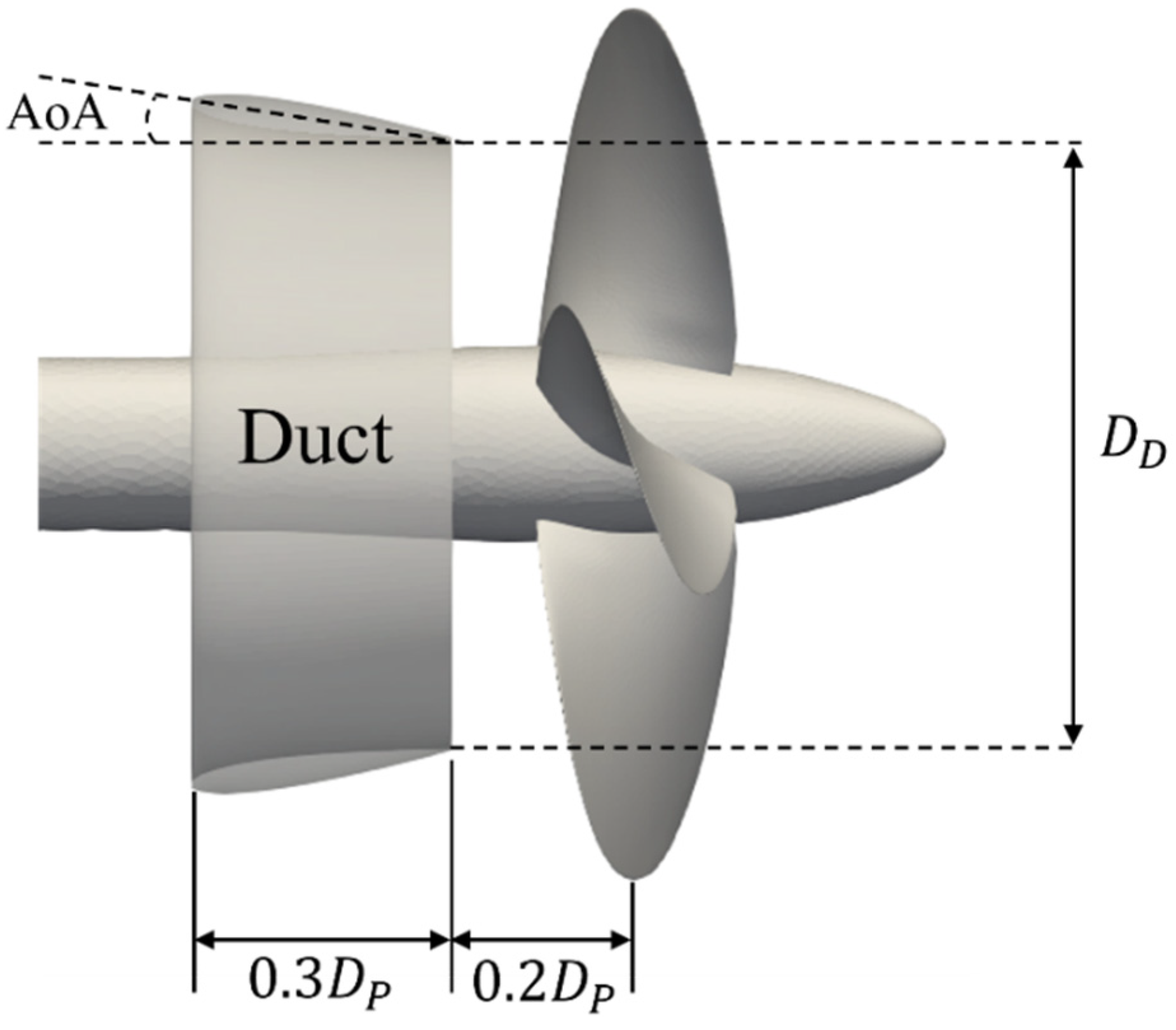
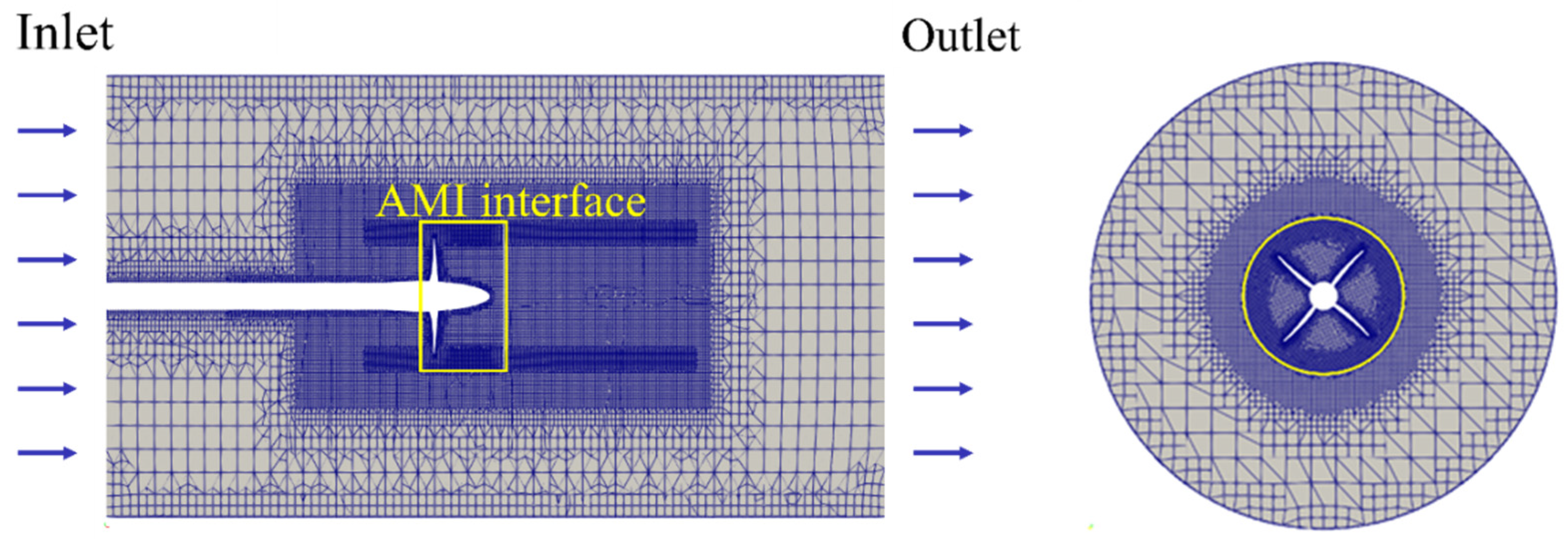
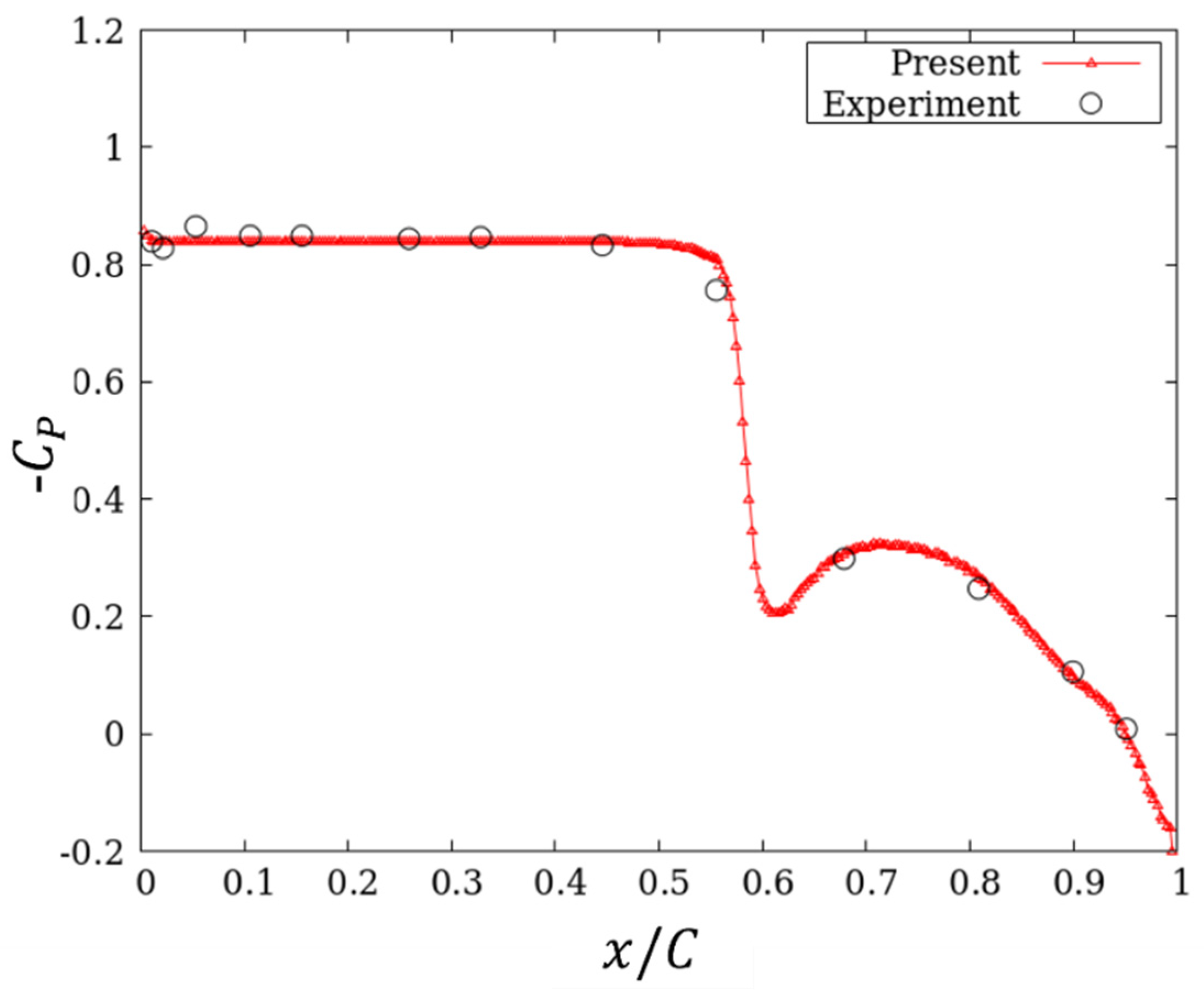
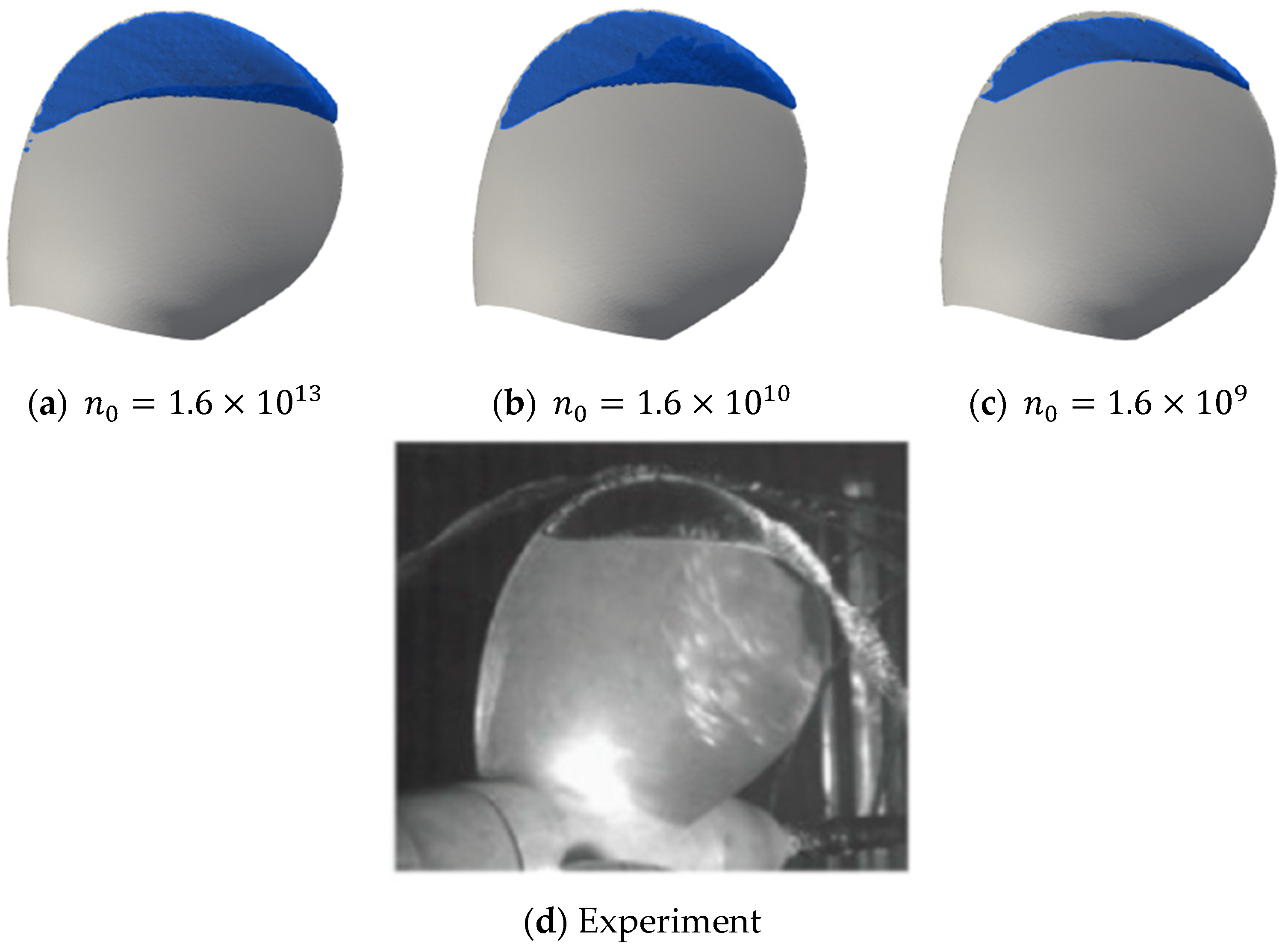
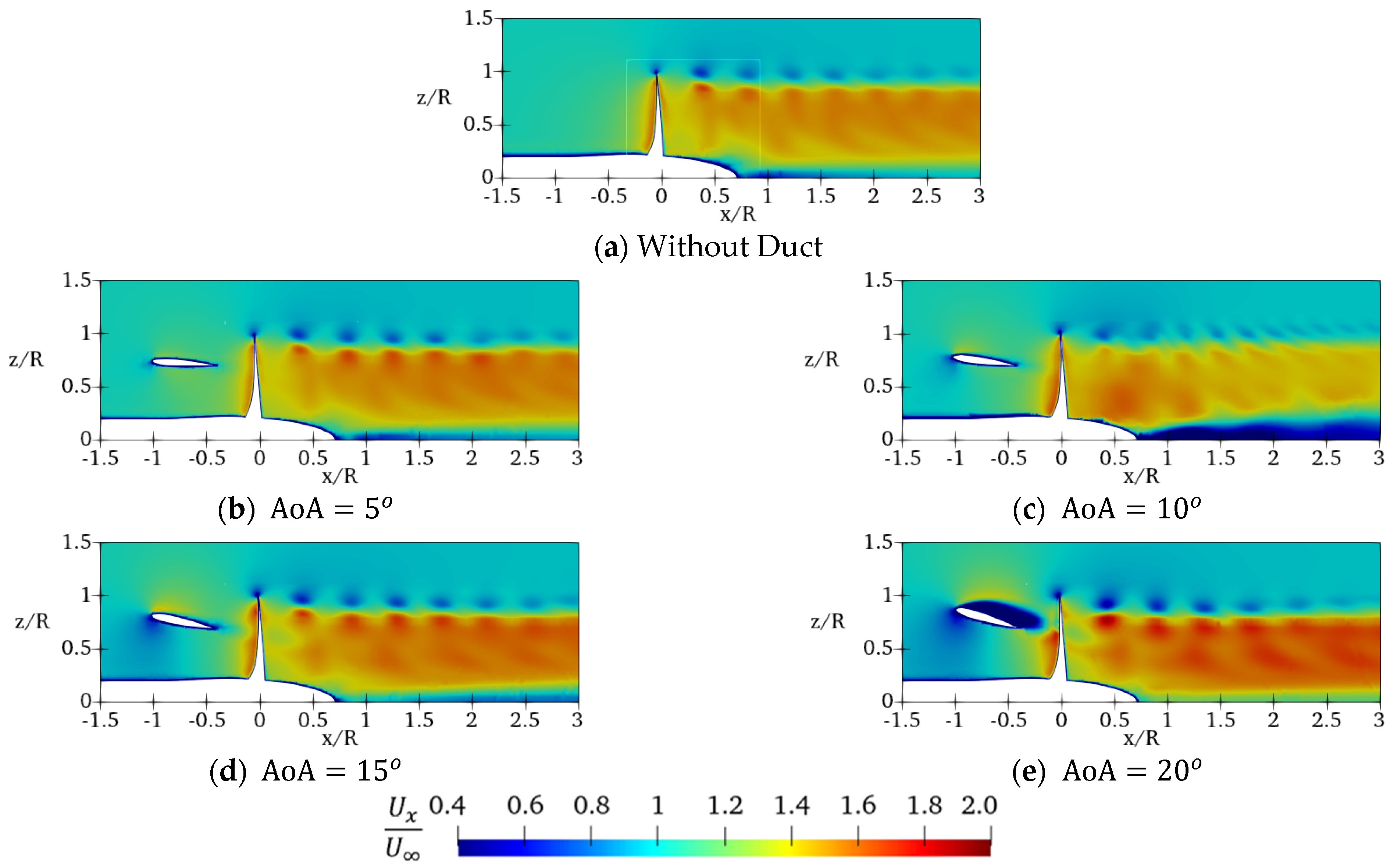

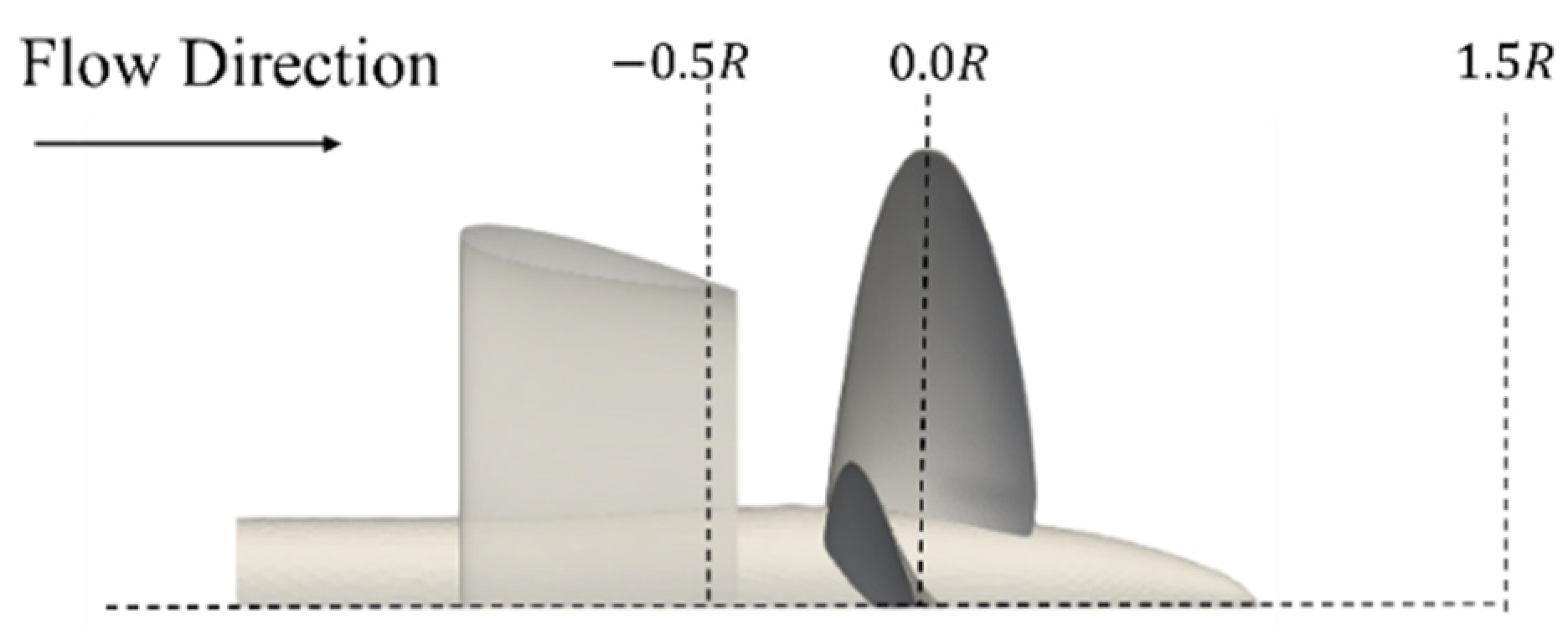



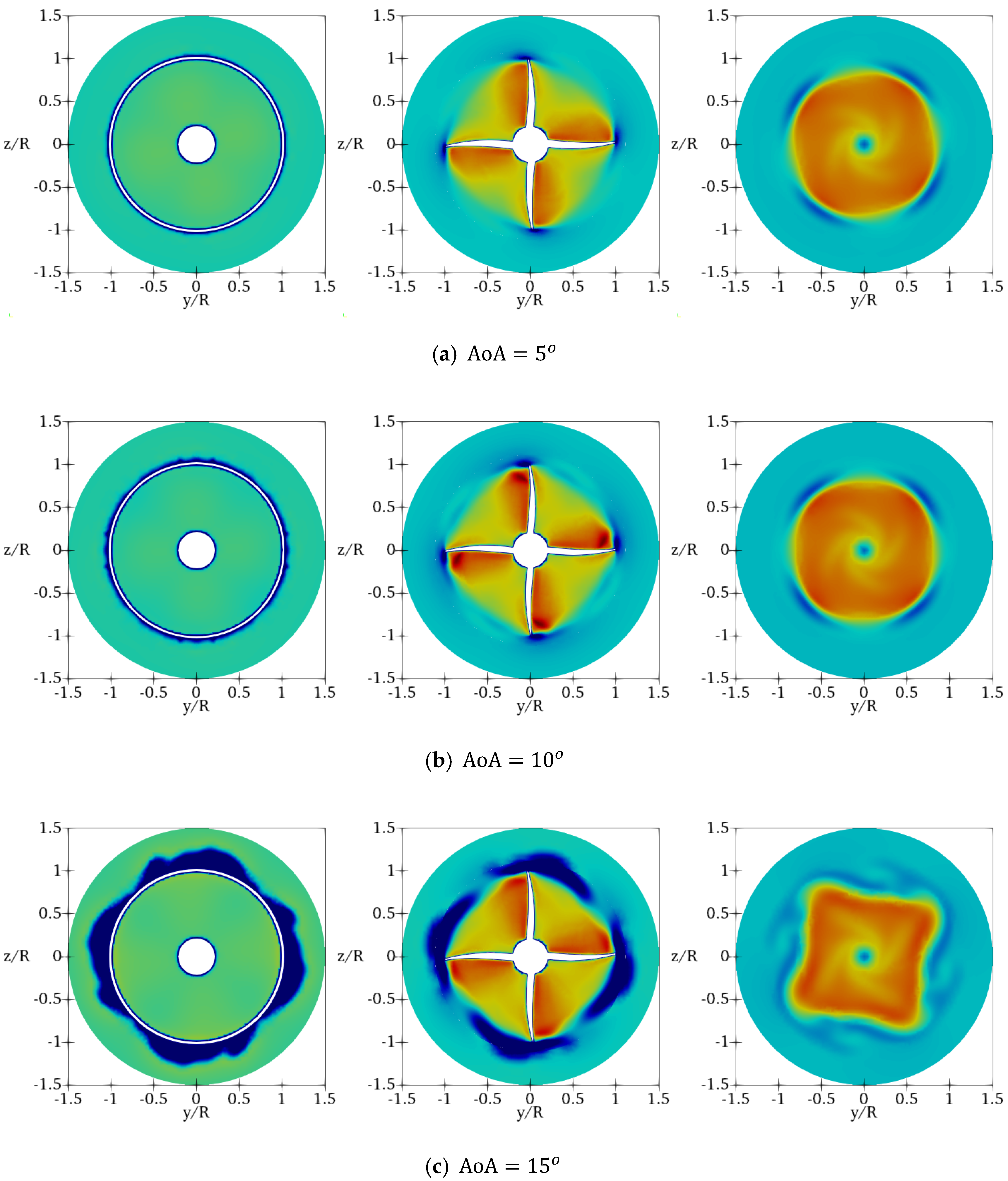
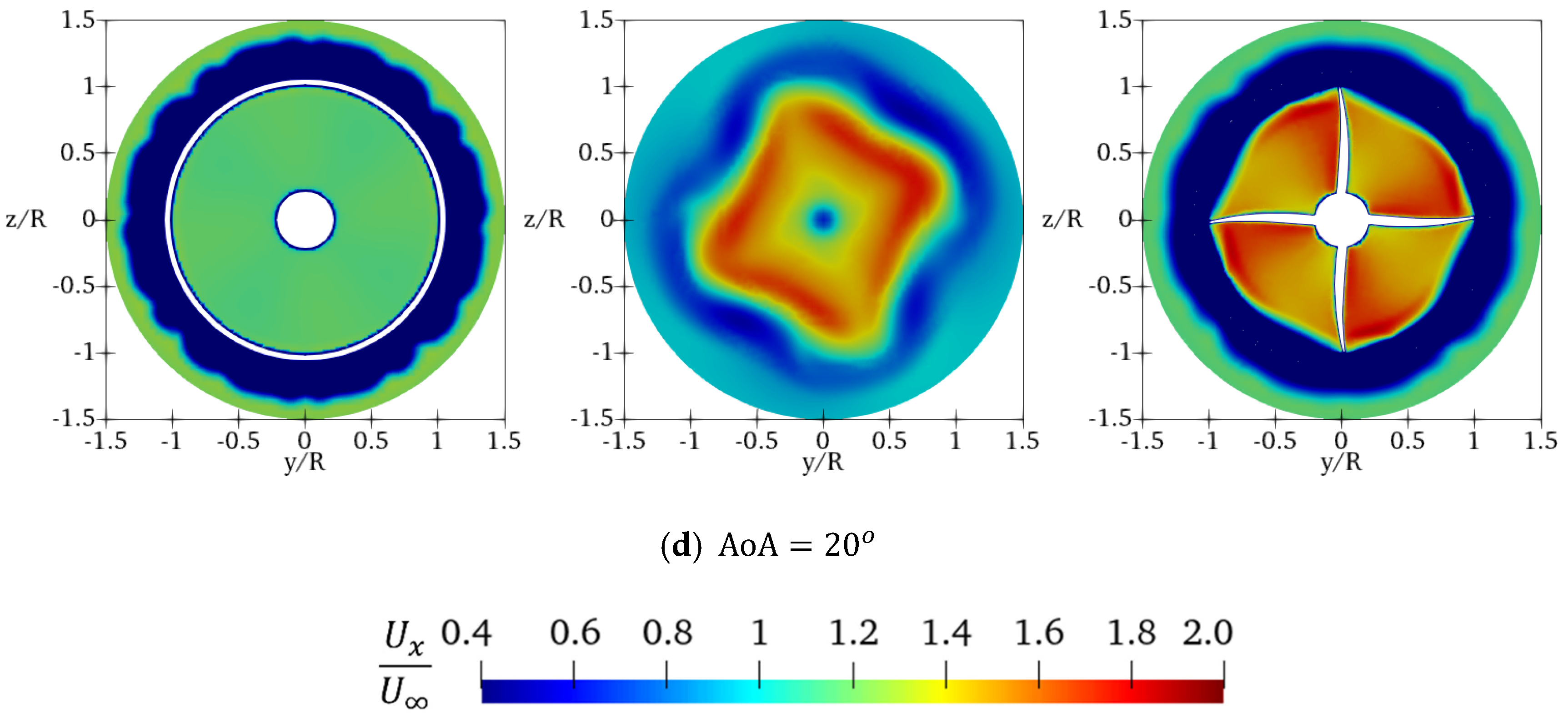

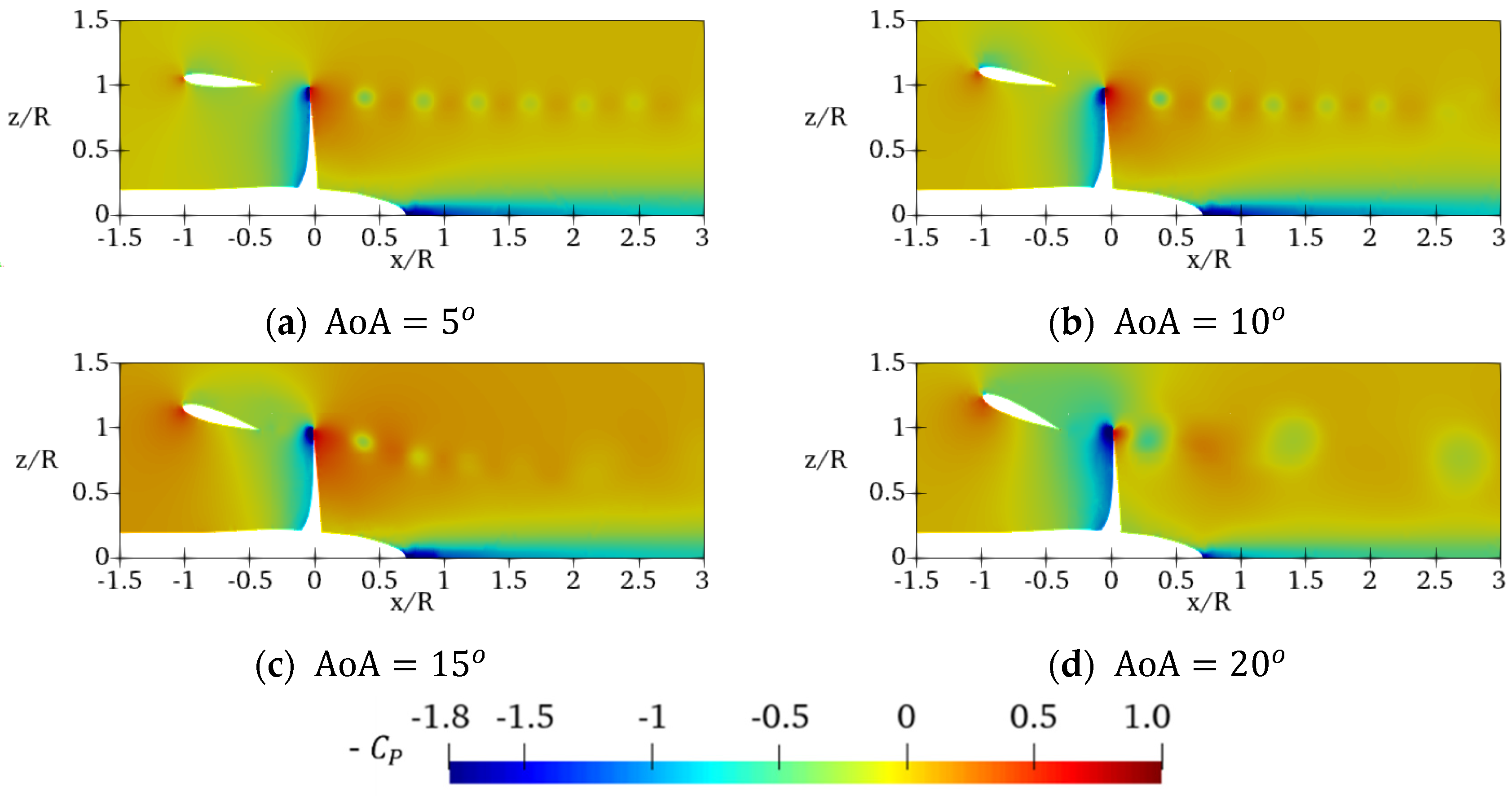
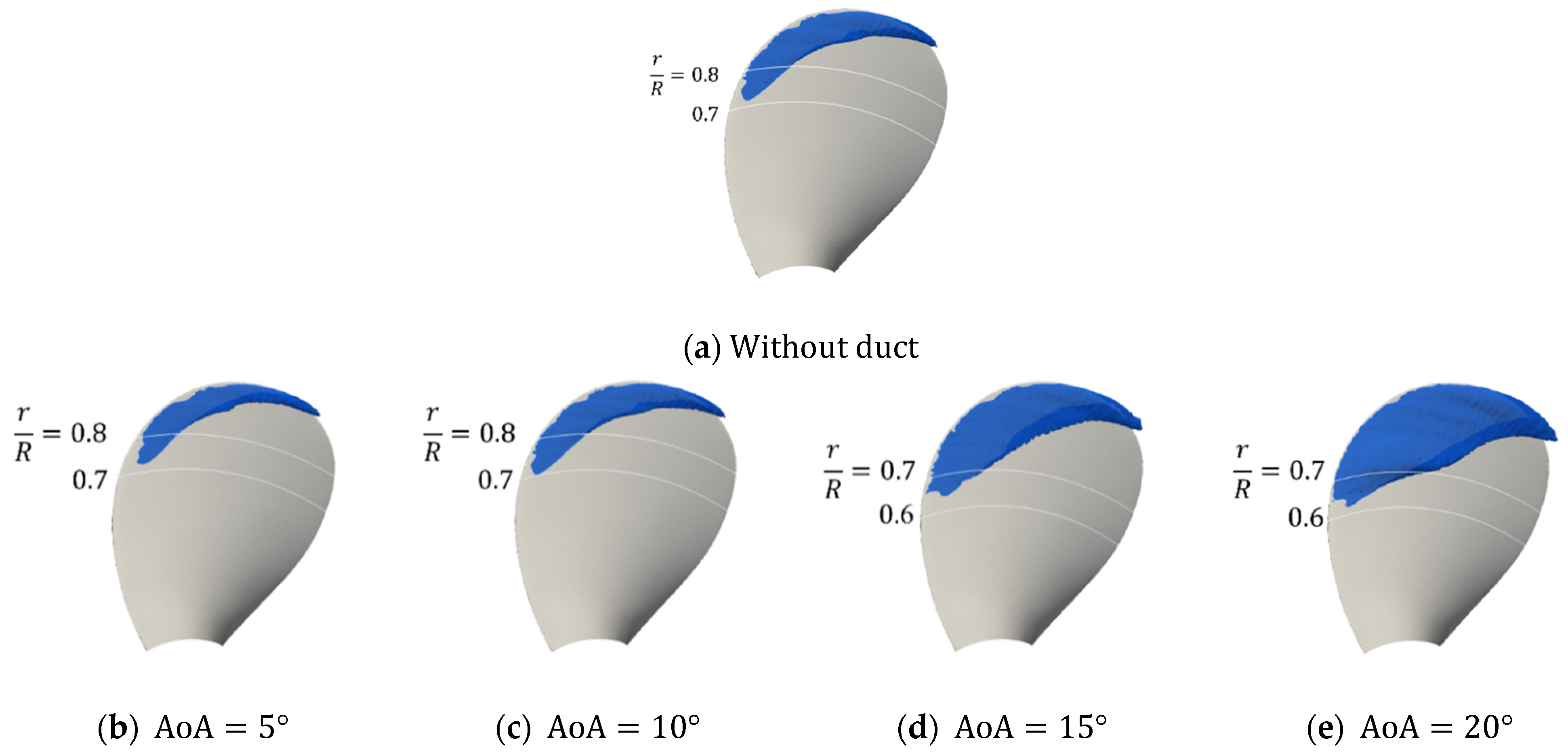

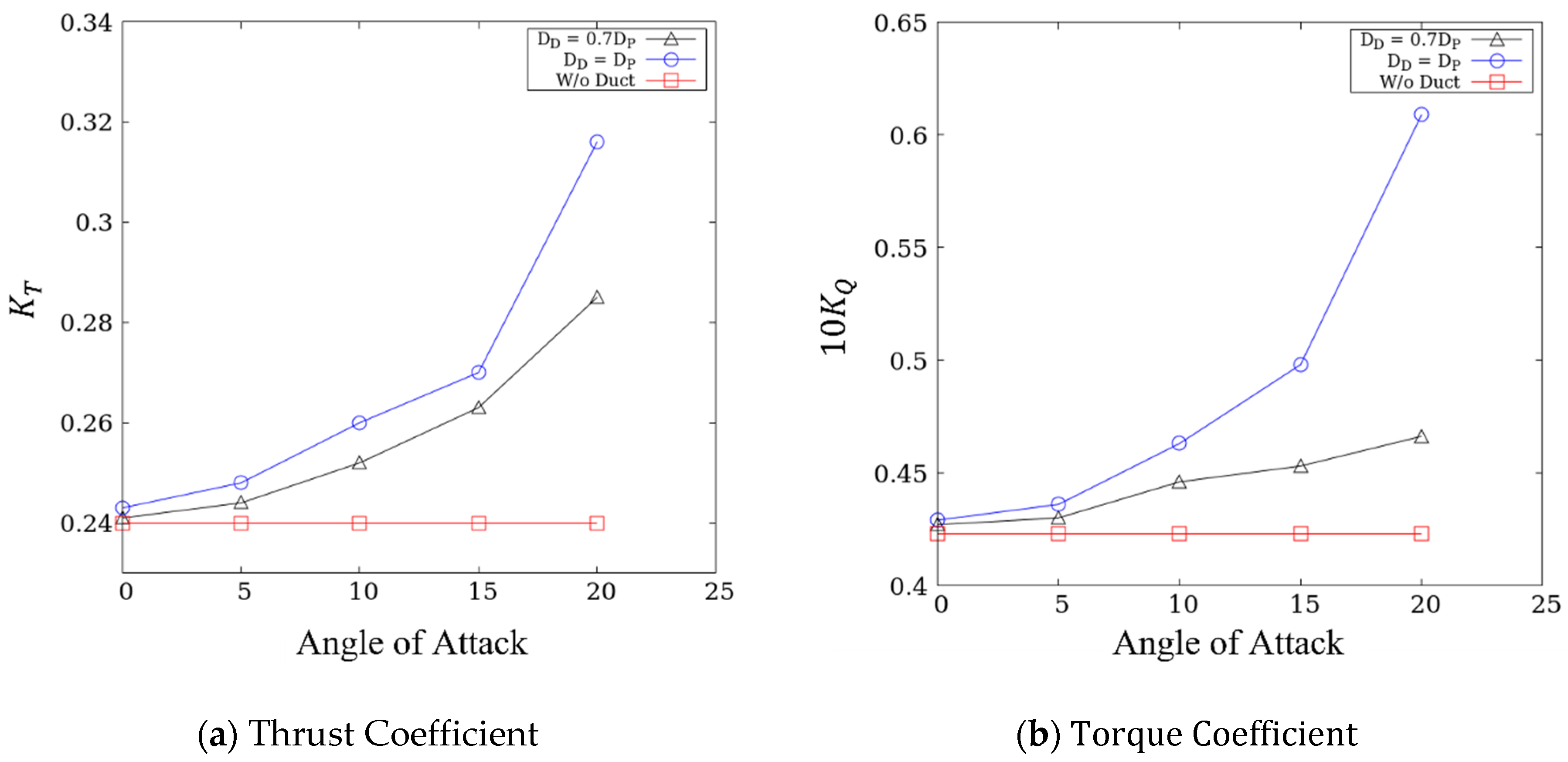
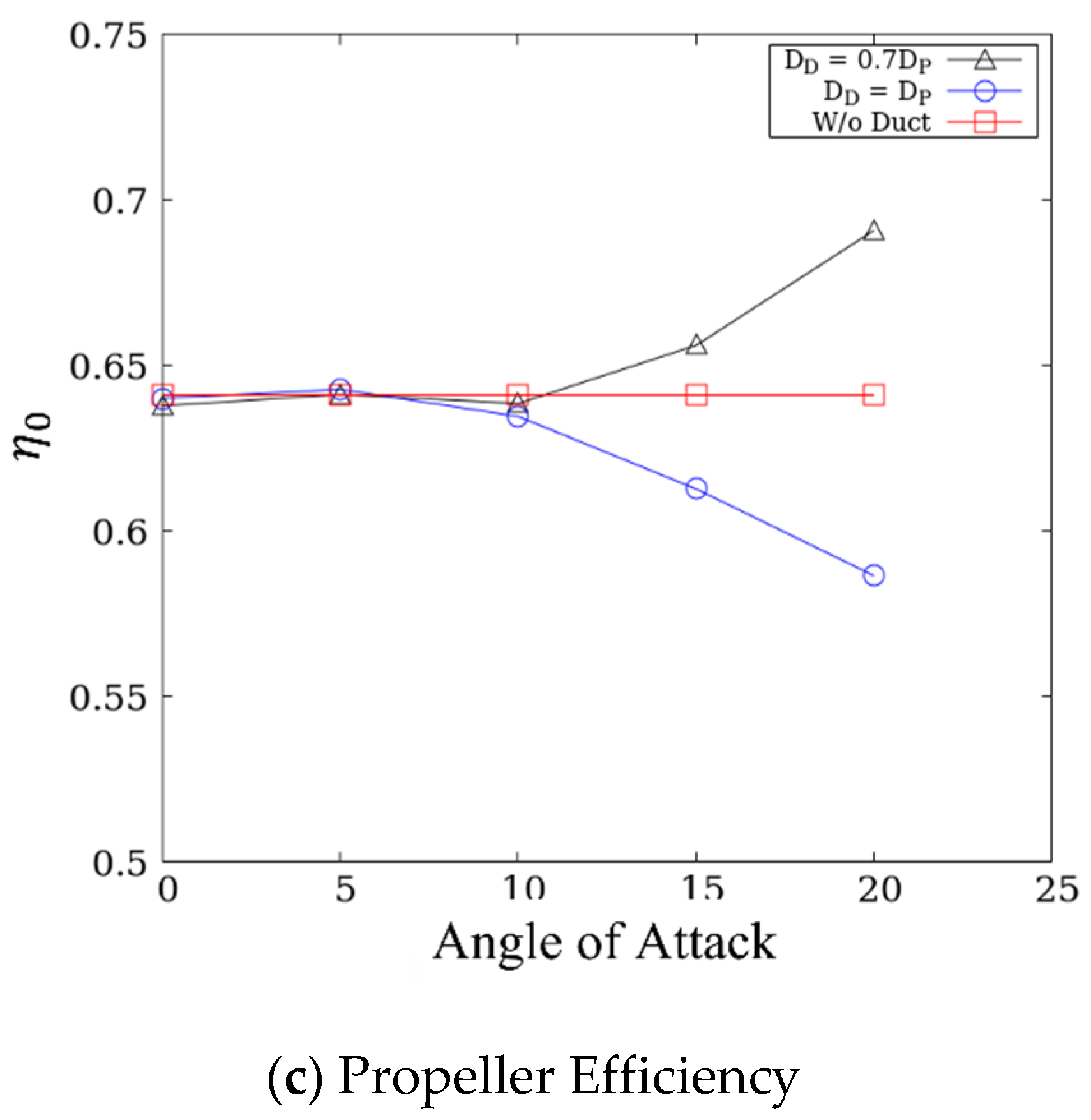
| No. of Blades | 4 |
| Diameter (m) | 0.227227 |
| Pitch ratio (P/D) at r/R = 0.7 | 1.1 |
| Pitch (P) (m) | 0.15225 |
| ) | 0.69 |
| Experiment (Salvatore et al. [22]) | Present | Difference (%) | Experiment (Salvatore et al. [22]) | Present | Difference (%) | Experiment (Salvatore et al. [22]) | Present | Difference (%) | |
|---|---|---|---|---|---|---|---|---|---|
| 0.099 | 0.508 | 0.492 | 3.150 | 0.829 | 0.802 | 3.257 | 0.097 | 0.097 | 0.111 |
| 0.298 | 0.430 | 0.428 | 0.465 | 0.707 | 0.709 | 0.283 | 0.288 | 0.286 | 0.746 |
| 0.498 | 0.340 | 0.339 | 0.294 | 0.574 | 0.577 | −0.523 | 0.469 | 0.466 | 0.813 |
| 0.695 | 0.245 | 0.239 | 2.449 | 0.438 | 0.461 | −5.251 | 0.619 | 0.573 | 7.316 |
| 0.895 | 0.150 | 0.147 | 2.000 | 0.294 | 0.302 | −2.721 | 0.727 | 0.693 | 4.596 |
| 0.970 | 0.111 | 0.105 | 5.450 | 0.234 | 0.221 | 5.556 | 0.732 | 0.733 | −0.159 |
| 1.094 | 0.044 | 0.042 | 5.000 | 0.135 | 0.238 | 5.926 | 0.567 | 0.573 | −0.984 |
Publisher’s Note: MDPI stays neutral with regard to jurisdictional claims in published maps and institutional affiliations. |
© 2022 by the authors. Licensee MDPI, Basel, Switzerland. This article is an open access article distributed under the terms and conditions of the Creative Commons Attribution (CC BY) license (https://creativecommons.org/licenses/by/4.0/).
Share and Cite
Ng’aru, J.M.; Park, S. CFD Simulations of the Effect of Equalizing Duct Configurations on Cavitating Flow around a Propeller. J. Mar. Sci. Eng. 2022, 10, 1865. https://doi.org/10.3390/jmse10121865
Ng’aru JM, Park S. CFD Simulations of the Effect of Equalizing Duct Configurations on Cavitating Flow around a Propeller. Journal of Marine Science and Engineering. 2022; 10(12):1865. https://doi.org/10.3390/jmse10121865
Chicago/Turabian StyleNg’aru, Joseph Mwangi, and Sunho Park. 2022. "CFD Simulations of the Effect of Equalizing Duct Configurations on Cavitating Flow around a Propeller" Journal of Marine Science and Engineering 10, no. 12: 1865. https://doi.org/10.3390/jmse10121865
APA StyleNg’aru, J. M., & Park, S. (2022). CFD Simulations of the Effect of Equalizing Duct Configurations on Cavitating Flow around a Propeller. Journal of Marine Science and Engineering, 10(12), 1865. https://doi.org/10.3390/jmse10121865







